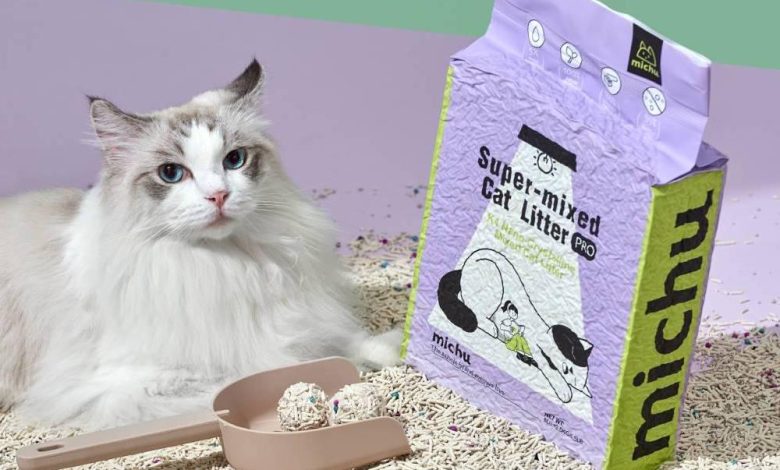The Role of Mixed Cat Litter in Reducing Pet Allergies and Sensitivities

Pet allergies and sensitivities can pose significant challenges for both cats and their owners. For many households, finding a cat litter that minimizes allergens and irritants is essential for maintaining a healthy environment. Mixed cat litter, which combines different materials, offers a potential solution to this problem. In this blog, we will explore how Mixed cat litter can help reduce pet allergies and sensitivities and what to consider when selecting the best option for your furry friend.
1. Understanding Pet Allergies and Sensitivities
Common Allergens in Cat Litter
- Dust: Traditional clay-based litters can produce dust when poured or scooped, which may trigger respiratory issues in both cats and humans. Dust is a common allergen and can exacerbate conditions like asthma or allergies.
- Fragrances and Additives: Some litters contain synthetic fragrances or chemical additives designed to mask odors. These can cause allergic reactions or sensitivities in sensitive pets and individuals.
Symptoms to Watch For
- In Cats: Symptoms of allergies or sensitivities in cats may include sneezing, coughing, itchy skin, or excessive grooming. Cats may also avoid the litter box if it causes discomfort.
- In Humans: Pet owners might experience respiratory issues, skin irritation, or allergic reactions due to the litter. Reducing allergens in the litter can improve overall comfort and health for everyone in the household.
2. Benefits of Mixed Cat Litter for Allergy Management
Low Dust Formulations
- Combination of Materials: Mixed cat litters often include a blend of materials designed to minimize dust. For example, combining clay with biodegradable ingredients like corn or paper can reduce the amount of dust produced during use.
- Reduced Respiratory Irritation: Less dust means fewer respiratory irritants, which can be beneficial for both cats with respiratory issues and humans with allergies or asthma.
Natural Odor Control
- Absence of Synthetic Fragrances: Many mixed cat litters focus on natural odor control methods, such as using activated charcoal or plant-based ingredients. These options help manage odors without relying on synthetic fragrances, reducing the risk of allergic reactions.
- Effective Odor Neutralization: Natural odor control agents in mixed litters can effectively neutralize odors without overwhelming fragrances, providing a more comfortable environment for sensitive pets and owners.
3. Choosing the Right Mixed Cat Litter for Allergies
Opt for Low Dust and Hypoallergenic Options
- Dust-Free Ingredients: Look for mixed cat litters that advertise low dust or dust-free formulations. These litters are less likely to trigger respiratory issues and provide a cleaner environment.
- Hypoallergenic Blends: Some mixed litters are specifically designed to be hypoallergenic, combining materials that are less likely to cause sensitivities. Check product descriptions and labels for information on hypoallergenic properties.
Natural and Biodegradable Materials
- Plant-Based Materials: Litter made from natural, plant-based materials like corn, wheat, or paper is often less likely to cause allergies compared to traditional clay litters. These materials are more breathable and can reduce the presence of allergens.
- Biodegradable Options: Mixed cat litters that are fully biodegradable or compostable are generally free from synthetic chemicals and additives, making them a safer choice for sensitive pets.
4. Maintaining a Clean Litter Box to Minimize Allergens
Regular Scooping and Cleaning
- Daily Maintenance: Regular scooping and cleaning of the litter box can help minimize the buildup of allergens and bacteria. This practice is essential for maintaining a healthy environment for both pets and humans.
- Deep Cleaning: Periodically wash the litter box with mild, non-toxic cleaning solutions to remove any residual allergens and odors. Ensure that the box is completely dry before adding new litter.
Choosing the Right Litter Box
- Size and Design: Opt for a litter box that is appropriately sized for your cat and easy to clean. A larger box with higher sides can help contain litter and reduce tracking.
- Liner Options: Some litter boxes come with liners or can be used with them. Choose liners that are made from non-toxic, hypoallergenic materials to avoid adding additional allergens.
5. Consumer Feedback and Reviews
Real-Life Experiences
- Customer Reviews: Look for feedback from other pet owners who have used mixed cat litter specifically for allergy management. Reviews can provide insights into the effectiveness of various products and their impact on allergens.
- Expert Recommendations: Consult with veterinarians or pet care experts for recommendations on the best mixed cat litters for pets with allergies or sensitivities. They can offer professional advice based on their experience.
Trial and Adjustment
- Sample Products: If possible, try small quantities of different mixed cat litters to see how your cat responds. Monitor for any signs of discomfort or improvement in allergy symptoms.
- Gradual Transition: When switching to a new type of litter, gradually mix it with the old litter to help your cat adjust. This can reduce the chances of adverse reactions.
Conclusion
Mixed cat litter offers several benefits for managing pet allergies and sensitivities. By choosing low-dust, natural, and hypoallergenic options, you can create a more comfortable environment for both your cat and your household. Regular maintenance of the litter box and careful selection of litter materials are key to reducing allergens and improving overall health.
Understanding your cat’s needs and preferences, along with staying informed about new product innovations, will help you make the best choice for allergy management. With the right mixed cat litter, you can enhance your cat’s comfort and well-being while maintaining a healthier living space for everyone in your home.









